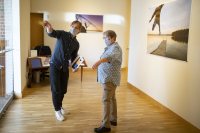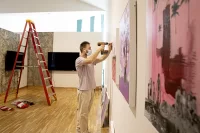
Museum internships reveal the art of creating an exhibition
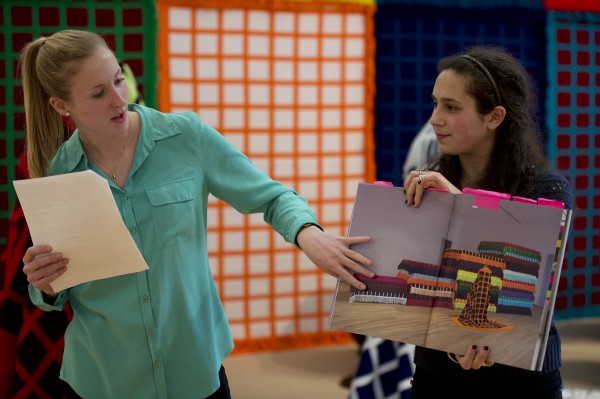
Bates Museum of Art interns Eliza Pyne ’13, at left, and Irem Ikizler ’15 discuss the art of Fransje Killaars in a March gallery talk for Killaars’ “Color at the Center,” an exhibition they helped prepare. Photograph by Michael Bradley/Bates College.
Until last winter, “I never handled a work of art other than my own,” says Doug Welsh ’14, a studio art major from San Ramon, Calif.
That changed when Welsh became a curatorial intern at the Bates College Museum of Art. Working with museum director Dan Mills, Welsh helped produce an exhibition of prints by Max Klinger, an intriguing 19th-century German artist whose work anticipated Surrealists like Salvador Dalí.
Welsh got to examine the Klinger prints up close and personal — wearing white cotton gloves and making notes with pencil, not pen, to avoid any risk of smudges or stains on the art.
“It was really cool,” Welsh says. “It’s entirely different when the art is outside of the glass and not on the museum wall.”
“To work directly with objects, to handle and learn about them and from them, to care for them, is an invaluable experience,” says museum curator Bill Low.
It’s an experience that a small museum “can provide in amazing ways” for students, he adds.
“When they study extraordinary works, or works by great artists, students are understandably awed and excited,” Low says. ” ‘Yes, this beautiful drawing is actually by Matisse. Yes, Cezanne worked directly on this rare lithograph.’ ”
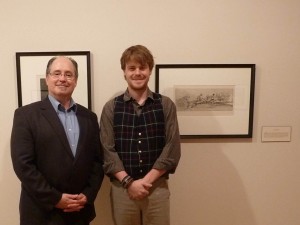
Doug Welsh ’14 worked with art museum director Dan Mills, left, to organize an exhibition of prints by 19th-century artist Max Klinger. Photograph courtesy of the Bates College Museum of Art.
Welsh was one of five interns involved in organizing exhibitions at the museum during the fall and winter of 2012-13. Two more curatorial interns, Cara Garcia-Bou ’13 of Eastchester, N.Y., and Nell Wachsberger ’13 of New York City, assisted with the exhibition Selections from the Permanent Collection: Recent Acquisitions, a showcase of museum purchases and gifts from alumni and friends.
For those three, the work entailed research into the artworks and artists, in addition to preparing the artworks for showing.
Two other students had a very different kind of experience. Eliza Pyne ’13 of Atherton, Calif., and Irem Ikizler ’15 of Nashville, Tenn., worked side-by-side with renowned Dutch artist Fransje Killaars on the creation of Color at the Center, a powerful exhibition of fabric installations that was divided between the Bates museum and Museum L/A, located in a former textile mill in downtown Lewiston.
Pyne and Ikizler were an important part of an installation crew of museum and facilities staff and local artists. “It’s unusual for students to have an opportunity to work so closely with a noted international artist and with community members,” said Mills. “They also presented a fine gallery talk about the Killaars exhibition and shared their insights with the public.”
For Ikizler and Pyne, working with the energetic and exacting Killaars was an unmatched experience. There was physical work (including ironing) and for Pyne, the opportunity to participate in a performance at the show’s opening while draped in one of Killaars’ fabric creations.
Most important, the pair were privy to many of the negotiations between artist and institution that led to a completed exhibition. “This understanding of collaboration is a concept that will ultimately serve me well in any field I work in,” says Ikizler.
Choosing works for the exhibition of recent additions to the museum’s collection, Wachsberger and Garcia-Bou had to make decisions about representing and explaining different media, and what to tell viewers in wall texts.
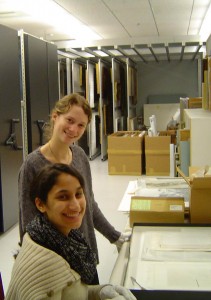
Seniors Nell Wachsberger, standing, and Cara Garcia-Bou helped prepare an exhibition of recent museum acquisitions. Photograph courtesy of the Bates College Museum of Art.
That gave Garcia-Bou insight into the factors a museum considers as it reaches out to diverse audiences. “At first the responsibility was a little scary,” she says. “But once we started thinking about who our audience was, it was easier to make the decisions.”
Welsh, too, needed to draft wall texts. There was library time involved, but because Welsh turned up only three books about Klinger (one by the artist himself), Mills urged Welsh to include his own interpretations of the work along with historical or technical perspectives.
He kept a museum journal and visited the works at length to develop sound impressions. “It was very personal and reflective,” says Welsh. A work like “Fallen Rider,” with a man pinned under his horse as a wolf and a flock of ravens look on, was rich with possible meanings.
“Klinger’s subject matter is just so fantastical and strange, and he plays with ambiguity and multiplicity,” Welsh says.
The Bates museum hosts three to six interns per semester — most often art and visual culture majors, but “we’ve had interns majoring in education, American cultural studies, women and gender studies, and more,” says Low. Interns work with education curator Anthony Shostak as well as Low and Mills. Access to the collections is integral all to the internships.
In addition to curatorial interns, there are collection-management interns who do research, process new acquisitions, maintain the collection database and assess the condition of works.
The staff prepares readings for the students to provide theoretical context for the hands-on work, and coordinates with the students’ advisers to ensure the experience is supporting the students’ larger academic goals. The interns produce reports at the end of their projects.
With a small staff, the museum benefits from the interns’ help. But what the students gain is irreplaceable: “a comparatively rare opportunity for hands-on work in a museum setting,” says Low. “It’s high-level work, access to collections and really professional training.
“It’s harder for larger museums to provide those kinds of opportunities.”
